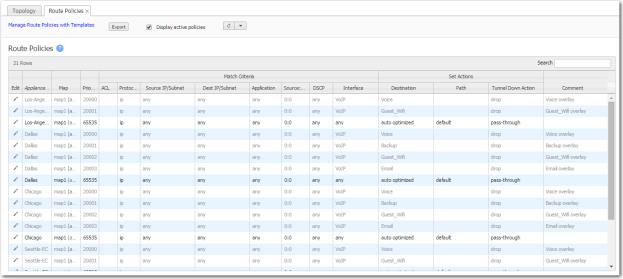The Route Policies report displays the route policy entries that exist on the appliance(s).
Each appliance's default behavior is to auto-optimize all IP traffic, automatically directing flows to the appropriate tunnel. Auto-optimization strategies reduce the need to create explicit route map entries for optimization. The three strategies that Silver Peak uses are TCP-based auto-opt, IP-based auto-opt, and subnet sharing. By default, all three are enabled on the Templates tab, under System.
|
•
|
You may also want to create a Route Policy entry when multiple tunnels exist to the remote peer, and you want the appliance to dynamically select the best path based on one of these criteria:
Manage these instances on the Templates tab, or click the Edit icon to manage Route policies directly for a particular appliance.
|
•
|
If you are using Orchestrator templates to add route map entries, the Orchestrator will delete all entries from 1000 – 9999, inclusive, before applying its policies.
|
|
•
|
You can create rules from 1 – 999, which have higher priority than Orchestrator template rules.
|
|
•
|
Similarly, you can create rules from 10000 – 65534 which have lower priority than Orchestrator template rules.
|
|
n
|
To allow any IP address, use 0.0.0.0/0 (IPv4) or ::/0 (IPv6).
|
|
n
|
|
n
|

